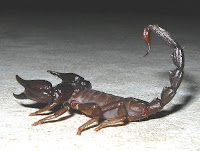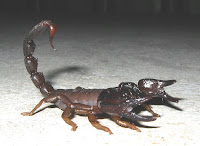







Sand Scorpion - Urodacus planimanus
A large robust scorpion to 10 cm (4") overall length, but unless you often check outside at night, after rain and during warm weather, you would never know they were around. They don't need to eat often and can go for many months without food, so to catch them out of their burrow is not a common occurrence. They dig very deep spiral burrows in sandy soil, or may construct a more shallow one under something solid, like a rock or large log, but they are very secretive where they do this.
Despite their impressive size and looking like a military tank full on, they are not aggressive and their sting is usually not serious, but like most stinging invertebrates, it is best to keep your distance and not tempt fate. The animals above live in very deep acid sandy soil in a heathland environment dominated by Banksia speciosa.
They feed on other invertebrates and initially grasp them with their pincers and then use their stinger to kill. The victim is then drawn to the mouth parts where the soft/liquid tissues are sucked up and the hard exoskeleton is discarded. A very impressive animal and always a pleasure to encounter.